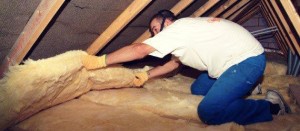 If your home is not insulated, you’re throwing money down the drain. It’s as simple as that – properties without proper or adequate insulation lost a quarter of their heat through the roof so that you’re left shivering and having to turn up your heating to maximum just to take the chill out of the air.
If your home is not insulated, you’re throwing money down the drain. It’s as simple as that – properties without proper or adequate insulation lost a quarter of their heat through the roof so that you’re left shivering and having to turn up your heating to maximum just to take the chill out of the air.
The reason why you lose money through your roof is down to basic physics – warm air rises, and if you don’t have a layer of protection to stop it escaping you’ll be left in an endless cycle of heating the cool air in your property, only to lose it again through the roof.
By preventing this from happening, you’ll not only be saving money on your energy bills but you’ll also be reducing your carbon dioxide emissions and doing your bit to stop climate change. You’ll also have more control over the temperature indoors.
The money you spend when you invest in loft insulation is a mere drop in the ocean compared to the money you’ll save on your energy bills. Given that decent insulation for your loft, attic or flat will last for 40 years, you’ll be saving year after year on your energy bills.
It is estimated that with loft insulation at a depth of 0 to 270mm, you could be saving up to £175 annually, with your choice of insulation paying for itself within two years.
Different Types of Insulation
There are different options of roof insulation that you can choose to suit your property type.
Blanket Insulation
This type of insulation is fairly easy for property owners to install for themselves. It’s a case of measuring up and cutting it down to the right size. Follow the manufacturer’s instructions to the letter and you won’t go far wrong. When you’re installing blanket insulation, make sure that you don’t damage it by tearing, stretching or squashing it to ensure that you get the best effects.
Board Insulation
This is an alternative to loft floor insulation, often used for loft conversions to keep in the warmth right up to the rafters. Board insulation is fixed to the inside of the roof, fixed between the rafters. You can purchase this insulation pre-cut or cut it into the desired strips yourself.
This is a slightly more complicated DIY task as you’ll have to inspect the roof to ensure that there’s no existing leaks before you install the board insulation, otherwise damp could set in. It’s also important to leave sufficient space between the boards and your roof tiles so that air can circulate, preventing condensation. This job is usually best undertaken by a professional roofing contractor – the investment will be worth every penny in the long-term.
Blown Insulation
This is a job for a trained roofer or insulation specialist. This type of insulation is ideal for lofts that are hard to access, where blanket insulation is unsuitable and the roof joists are obstructed. Blown insulation requires specialist equipment, which is used to blow loose insulation material into the loft. This material is made of fire-retardant cellulose fibre or mineral wool – it should only take a couple of hours for the work to be completed.
Flat roof insulation
With a flat roof, you’ll have to insulate from the outside. You can do this by adding insulation board over the top of your weather-proofed flat roof or if it’s a timber surface, reverse it and put the insulation underneath the waterproof layer. It’s best to get a professional roofer to do this for you. If you’re having a brand new flat roof, it’s a requirement to get it insulated anyway due to Building Regulations. A good roofer will factor this into the price when quoting for the work.
To complete your insulation, make sure you insulate your pipes and water tank too. This is particularly important if you’ve insulated your loft, because the roof space will be colder, so there’s more chance that your pipes will freeze in the winter. Make sure this doesn’t happen by insulating them.
You can also insulate the loft hatch to make sure that you keep out the cold completely.
Call G&A Roofing and Building for advice about roofing, loft insulation and home maintenance work.
Contact us for roof repairs and emergency repairs from a team of trained roofers. Speak to a professional roofer on 0800 626430.

 When you see this symbol you know you are dealing with a reputable roofing company
When you see this symbol you know you are dealing with a reputable roofing company